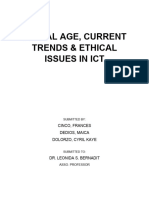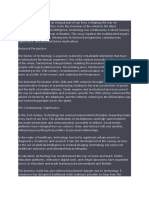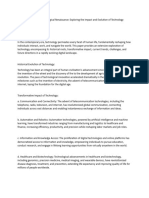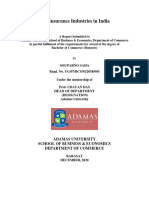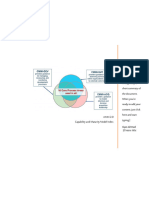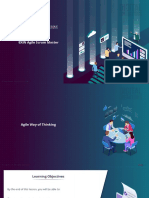Influence on Culture
1. Social Media Platforms: Social media, such as Facebook, Instagram, and TikTok, has
transformed how people communicate and share cultural content. For instance, viral
challenges and trends often originate on these platforms, shaping popular culture and
influencing fashion, music, and language. The rapid spread of memes and cultural
references demonstrates how IT fosters a shared cultural experience across diverse
demographics.
2. Global Cultural Exchange: The internet allows for the easy sharing of cultural practices
and ideas. For example, platforms like YouTube and Spotify enable users to access music
and art from around the world, promoting cross-cultural appreciation. This exchange can
lead to the blending of cultural elements, as seen in the rise of genres like K-pop, which
combines Western and Eastern musical influences.
3. Digital Activism: Movements such as #MeToo and Black Lives Matter have utilized social
media to raise awareness and mobilize support for social justice issues. These platforms
provide a voice to marginalized communities, demonstrating how IT can facilitate social
change and cultural dialogue.
Impact on Social Behavior
1. Changing Communication Styles: The rise of instant messaging and social networking
has altered interpersonal communication. While these technologies enable quick and
convenient interactions, they can also lead to a decline in face-to-face communication,
potentially resulting in feelings of isolation among individuals, particularly younger
generations.
2. Influence on Self-Identity: The curated nature of social media profiles can impact users'
self-esteem and self-perception. Studies have shown that constant exposure to idealized
images can lead to anxiety and depression, as individuals compare themselves to others.
This phenomenon highlights the psychological effects of digital culture on personal
identity.
3. Digital Addiction: The compulsive use of smartphones and social media is becoming
increasingly common, with many individuals struggling to disconnect. This addiction can
interfere with daily life, affecting relationships and mental health, as users prioritize
online interactions over real-life connections.
Transformation of Industries
1. E-Commerce Revolution: The growth of online shopping platforms like Amazon and
Alibaba has transformed the retail landscape. Consumers can now purchase products
� from anywhere in the world, leading to increased competition and the need for
traditional retailers to adapt to an online marketplace.
2. Disruptive Technologies: Innovations such as artificial intelligence (AI) and cloud
computing are reshaping industries. For example, companies like Uber and Airbnb have
disrupted traditional transportation and hospitality sectors by leveraging technology to
create new business models that prioritize convenience and accessibility.
3. Job Market Evolution: The integration of IT into various industries has led to the
automation of many tasks, changing the nature of work. Workers are now required to
develop new skills to keep pace with technological advancements, leading to a shift in
workforce dynamics and the emergence of new job roles.
Conclusion
In conclusion, Information Technology profoundly influences culture, social behavior, and
industries. It shapes how we communicate, interact, and conduct business, while also
presenting challenges that society must address. As IT continues to evolve, understanding its
impact will be crucial for navigating the complexities of our digital world.
1. The Internet of Things (IoT)
The IoT refers to the network of interconnected devices that communicate and exchange data
over the internet. This technology has profound implications for both personal and professional
spheres.
Smart Homes: IoT devices, such as smart thermostats, security cameras, and voice-
activated assistants (e.g., Amazon Alexa, Google Home), have made homes more
efficient and secure. For instance, smart thermostats can learn user preferences and
optimize energy usage, leading to cost savings and reduced environmental impact.
Healthcare Innovations: In healthcare, IoT devices like wearable fitness trackers and
remote monitoring systems enable continuous health tracking. For example, patients
with chronic conditions can use IoT devices to send real-time data to healthcare
providers, allowing for timely interventions and personalized care.
Smart Cities: IoT technology is also being implemented in urban planning. Smart traffic
lights, waste management systems, and public transportation monitoring enhance city
efficiency and improve the quality of life for residents. For instance, smart traffic systems
can reduce congestion by adjusting signal timings based on real-time traffic data.
2. Automation
�Automation involves the use of technology to perform tasks with minimal human intervention,
significantly impacting various industries and the workforce.
Manufacturing Efficiency: In manufacturing, automation has led to increased
productivity and reduced costs. Robotics and automated assembly lines enable
companies to produce goods faster and with greater precision. For example, automotive
manufacturers use robotic arms for tasks such as welding and painting, resulting in
higher quality and lower labor costs.
Service Industry Transformation: Automation is also transforming the service industry.
Self-service kiosks in restaurants and retail stores streamline operations and enhance
customer experience. For instance, fast-food chains like McDonald's have implemented
self-ordering kiosks, allowing customers to customize their orders while reducing wait
times.
Job Displacement and Creation: While automation increases efficiency, it also raises
concerns about job displacement. Many routine jobs are at risk of being automated,
leading to a shift in the job market. However, automation also creates new opportunities
in technology development, maintenance, and oversight, necessitating a workforce
skilled in these areas.
3. Digital Platforms
Digital platforms have reshaped how individuals and businesses interact, facilitating
communication, commerce, and collaboration.
E-Commerce Growth: Platforms like Amazon, eBay, and Etsy have transformed retail by
enabling consumers to shop online from anywhere in the world. This shift has led to the
decline of traditional brick-and-mortar stores and has forced businesses to adapt their
strategies to remain competitive.
Social Connectivity: Social media platforms such as Facebook, Twitter, and Instagram
have changed how people connect and share information. These platforms allow users
to maintain relationships across distances, share experiences, and engage in discussions
on various topics, fostering a sense of community.
Gig Economy: Digital platforms have given rise to the gig economy, where individuals can
offer services on-demand through apps like Uber, Lyft, and TaskRabbit. This model
provides flexibility for workers but also raises questions about job security and benefits.
Conclusion
�In summary, the Internet of Things, automation, and digital platforms have profoundly impacted
modern society. They enhance efficiency, improve quality of life, and reshape industries while
also presenting challenges related to job displacement and privacy concerns. As these
technologies continue to evolve, it is essential for society to adapt and address the implications
of these changes to ensure a balanced and equitable future.
Bookmark messageCopy messageExport
Case Studies
Facial Recognition Technology and Its Implications
Facial recognition technology has become increasingly prevalent in various sectors, particularly
in law enforcement and public safety. A notable case study examines its implementation in
urban areas, where police departments have adopted this technology to enhance security
measures. While facial recognition can aid in identifying suspects and preventing crime, it raises
significant ethical concerns regarding privacy and civil liberties.
One major issue is the potential for racial bias inherent in these systems. Research has shown
that facial recognition algorithms often misidentify individuals from minority groups at higher
rates than their white counterparts. For instance, a study by the MIT Media Lab found that facial
recognition systems misclassified the gender of darker-skinned women 34% of the time,
compared to a 1% error rate for lighter-skinned men. This disparity can lead to wrongful
accusations and reinforce systemic biases within law enforcement practices.
Moreover, the use of facial recognition technology in public spaces raises questions about
surveillance and the erosion of privacy. Citizens may be monitored without their consent,
leading to a chilling effect on free expression and assembly. As a result, many advocacy groups
are calling for stricter regulations and transparency regarding the use of facial recognition
technology. This case study highlights the need for a balanced approach that considers both the
benefits of enhanced security and the ethical implications of surveillance technologies in
society.
Statistical Data
The Impact of Automation on Employment
The rise of automation and artificial intelligence (AI) has transformed industries and the
workforce landscape. A significant report from McKinsey Global Institute estimates that by
2030, up to 375 million workers, or approximately 14% of the global workforce, may need to
�change occupations due to automation. This statistic underscores the profound impact of
technological advancements on employment and the necessity for workforce reskilling.
The report highlights that while automation can lead to increased efficiency and productivity, it
also poses challenges for workers in routine and manual jobs. Sectors such as manufacturing,
retail, and transportation are particularly vulnerable, as machines and algorithms can perform
tasks traditionally done by humans. For example, self-checkout systems in grocery stores and
automated delivery services are reshaping the retail landscape, reducing the need for cashiers
and delivery personnel.
To address these challenges, the report emphasizes the importance of reskilling and upskilling
initiatives. Workers must be equipped with new skills to adapt to the changing job market,
particularly in areas such as technology, healthcare, and renewable energy. Governments,
educational institutions, and businesses must collaborate to create training programs that
prepare the workforce for the future. This statistical data highlights the urgent need for
proactive measures to ensure that workers are not left behind in the face of rapid technological
change, ultimately fostering a more resilient and adaptable workforce.
Ethical Discussions
Data Privacy and Security in the Digital Age
In today's digital landscape, data privacy and security have emerged as critical ethical issues.
With the increasing amount of personal data collected by companies, concerns about how this
data is used, stored, and shared have intensified. A prominent example is the Cambridge
Analytica scandal, where personal data from millions of Facebook users was harvested without
consent for political advertising. This incident raised significant questions about user consent,
data protection, and the ethical responsibilities of tech companies.
The ethical implications of data privacy extend beyond individual cases to broader societal
concerns. Users often unknowingly consent to data collection through lengthy terms and
conditions, leading to a lack of awareness about how their information is utilized. This situation
highlights the need for greater transparency and accountability in data practices. Companies
must prioritize user privacy and implement robust data protection measures to safeguard
personal information.
Moreover, the ethical discussion surrounding data privacy emphasizes the importance of
informed consent. Users should have clear and accessible information about what data is being
collected and how it will be used. Additionally, there is a growing call for regulations that
protect consumer data, such as the General Data Protection Regulation (GDPR) in the European
Union. This ethical discourse underscores the need for a balanced approach that respects
�individual privacy rights while allowing for innovation and technological advancement in the
digital age.
Algorithmic Bias and Its Ethical Implications
Algorithmic bias is a pressing ethical issue in the realm of Information Technology, particularly
as artificial intelligence (AI) systems become more integrated into decision-making processes.
Algorithms are designed to analyze data and make predictions, but they can inadvertently
perpetuate existing biases present in the training data. A notable example is in hiring
algorithms, which may favor certain demographics based on historical data, leading to
discrimination in recruitment practices.
Research has shown that biased algorithms can disproportionately affect marginalized groups.
For instance, a study by ProPublica revealed that a widely used algorithm for predicting
recidivism in criminal justice was biased against African American defendants, falsely flagging
them as higher risk compared to their white counterparts. This raises ethical concerns about
fairness and accountability in automated decision-making systems.
The ethical discussion surrounding algorithmic bias emphasizes the need for transparency in
algorithm design and the importance of diverse data sets. Developers must be aware of the
potential biases in their data and take steps to mitigate them. Additionally, there is a growing
call for regulatory frameworks that ensure fairness and accountability in AI systems. This ethical
discourse highlights the responsibility of tech companies to create equitable algorithms that do
not reinforce societal inequalities, ultimately fostering a more just and inclusive technological
landscape.





























